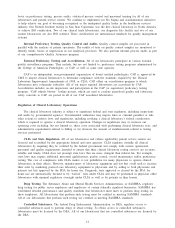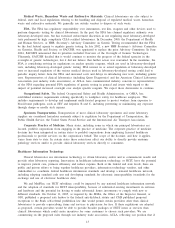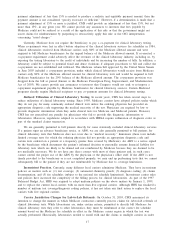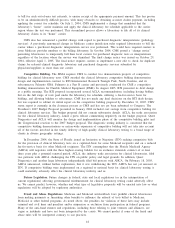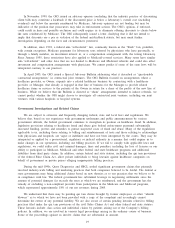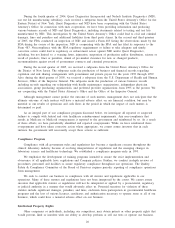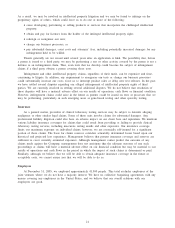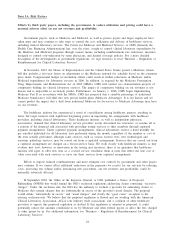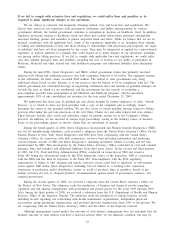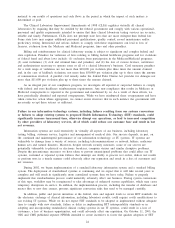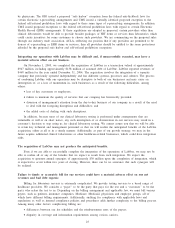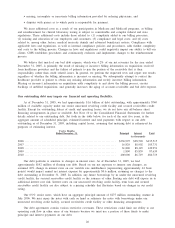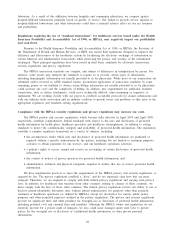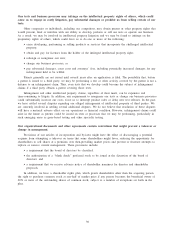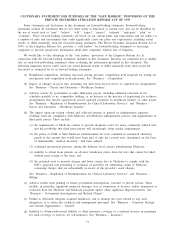Quest Diagnostics 2005 Annual Report Download - page 39
Download and view the complete annual report
Please find page 39 of the 2005 Quest Diagnostics annual report below. You can navigate through the pages in the report by either clicking on the pages listed below, or by using the keyword search tool below to find specific information within the annual report.
Item 1A. Risk Factors
Efforts by third party payers, including the government, to reduce utilization and pricing could have a
material adverse effect on our net revenues and profitability.
Government payers, such as Medicare and Medicaid, as well as private payers and larger employers have
taken steps and may continue to take steps to control the cost, utilization and delivery of healthcare services,
including clinical laboratory services. The Center for Medicare and Medicaid Services, or CMS (formerly the
Health Care Financing Administration) has, over the years, sought to control clinical laboratory expenditures by
the Medicare and Medicaid programs through various means, including reimbursement rate reductions, measures
designed to control over-utilization by some physicians, and limited coverage policies. For a more detailed
description of the developments in government regulations, we urge investors to read “Business – Regulation of
Reimbursement for Clinical Laboratory Services’’.
In November 2003, the House of Representatives and the United States Senate passed a Medicare reform
bill that includes a five-year freeze on adjustments to the Medicare national fee schedule based on the consumer
price index. Congressional budget reconciliation efforts could result in further reductions in Medicare and/or
Medicaid expenditures for laboratory services in 2006. In addition, as required by the Medicare Prescription
Drug, Improvement, and Modernization Act of 2003 (MMA), CMS will conduct two demonstration projects of
competitive bidding for clinical laboratory services. The impact of competitive bidding on our revenues is not
known and is impossible to accurately predict. Furthermore, on January 1, 2006, CMS began implementing
Medicare Part D in accordance with the MMA. CMS has projected that a sizeable percentage of traditional
Medicare beneficiaries will shift into new private health plans (Medicare Advantage). It is not known and we
cannot predict the impact that a shift from traditional Medicare fee-for-service to Medicare Advantage may have
on our revenues.
The healthcare industry has experienced a trend of consolidation among healthcare insurers, resulting in
fewer but larger insurers with significant bargaining power in negotiating fee arrangements with healthcare
providers, including clinical laboratories. These healthcare insurers, as well as independent physician
associations, demand that clinical laboratory service providers accept discounted fee structures, or assume all or
a portion of the financial risk associated with providing testing services to their members through capitated
payment arrangements. Under capitated payment arrangements, clinical laboratories receive a fixed monthly fee
per enrolled individual for all laboratory tests performed during the month, regardless of the number or cost of
the tests actually performed, although some services, such as various esoteric tests, new technologies and
anatomic pathology services, may be carved out from a capitated arrangement. Services that are carved out from
a capitated arrangement are charged on a fee-for-service basis. We work closely with healthcare insurers as they
evaluate new tests; however, as innovation in the testing area increases, there is no guarantee that healthcare
insurers will agree to offer new tests as a covered service, reimburse them at rates that reflect the true cost or
value associated with such services or carve out these services from capitated arrangements.
Efforts to impose reduced reimbursements and more stringent cost controls by government and other payers
may continue. If we cannot offset additional reductions in the payments we receive for our services by reducing
costs, increasing test volume and/or introducing new procedures, our net revenues and profitability could be
materially adversely affected.
In September 2003, the Office of the Inspector General, or OIG, published a Notice of Proposed
Rulemaking (NPRM) that would amend the OIG’s exclusion regulations addressing claims containing “excessive
charges’’. Under the exclusion rule, the OIG has the authority to exclude a provider for submitting claims to
Medicare that contain charges that are substantially in excess of the provider’s usual charges. The proposal
would define “substantially in excess’’ and “usual charges’’ and clarify the “good cause’’ exception to the
existing exclusion rule. We believe that the proposed regulation is flawed and are working with the American
Clinical Laboratory Association, ACLA (our industry trade association), and a coalition of other healthcare
providers to oppose this proposed regulation as drafted. If this regulation is adopted as proposed, it could
potentially reduce the amounts reimbursed to us by Medicare and other federal payers or affect the fees charged
to other payers by us. For additional information, see “Business – Regulation of Reimbursement for Clinical
Laboratory Services’’.
22


